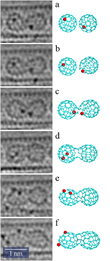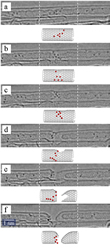Scientists to observe chemical reactions in real time and atomic space
November 26, 2009
ULM / NOTTINGHAM / STUTTGART / EINDHOVEN / HONG KONG - The AC-HR-TEM technique may ultimately improve the understanding of chemical reactions.
The understanding of how molecules react with each other is an ultimate quest of the chemical science. Even in seemingly simple chemical reactions the transformation may follow complicated pathways through a series of intermediates and transition states.
Conventional spectroscopy methods have been successfully used to unravel the mechanisms of chemical reactions however the direct observation of a chemical transformation of individual molecules has just recently become technically possible with the invent of aberration-corrected transmission electron microscope technology. It can provide invaluable insights into the chemistry of reactions.
By AC-HR-TEM at an acceleration voltage of 80 kV scientists of Ulm University , group of Electron Microscopy fro Materials Science (EMMS), together with scientists from the University of Nottingham, the Max- Planck Institute Stuttgart, the Eindhoven University of Technology and the Hong Kong University have observed a chemical transformation of individual Dysprosium (Dy) @ Fullerene (C82) (Dy3+) molecules located within a carbon nanotube in real space and real time via Dy-assisted breakdown of the C82 cage (see Figure 1 and 2).
View a video of the chemical reaction.
The observation of the reactions shows that a SWNT cannot be viewed as a simple inert container for reactive species as was reported in the literature.
Effectively, this means that they have obtained visual evidence for the transfer of kinetic energy from the incident electrons of the TEM beam to the heavy metal atoms and then on to the fullerenes—a process that facilitates the rupture of C-C bonds in the vicinity of the Dy atoms. As soon as the Dy atoms leave their cages, the scientists observe no further structural transformation of the internal nanotube formed out of fullerenes, indicating a generally catalytic role of Dy in carbon structures for the first time.
Apart from their fundamental scientific relevance, these accomplishments represent a practical approach to the creation of a new type of "test tube" for studying molecular samples. Apparently, carbon nanotubes not only serve to hold individual molecules in place during irradiation, but these nanometer-sized containers can also exert a well-defined influence on the chemical reactions that occur within their confines. Moreover, the observation opens new avenues for modifications of the inner surface of carbon nanotubes through insertion of strong oxidants into nanotube cavities and their subsequent activation by external stimuli, such as e-beam, UV-laser or heat.
Within the SALVE I-II project the strategy of combining low-dose electron microscopy with aberration-corrected operation at lower voltages might be the key to future and more detailed observations of chemical reactions also in other tube-shaped structures, such as electron-beam-sensitive microtubules This could help in coming steadily closer to understanding of how molecules react with each other; that’s of fundamental importance for medicine, science and technology.
About the article
Title: Observations of Chemical Reactions at the Atomic Scale: Dynamics of Metal-Mediated Fullerene Coalescence and Nanotube Rupture
Authors: Chuvilin, A., A. N. Khlobystov, D. Obergfell, M. Haluska, S. Yang, S. Roth, and U. A. Kaiser
Publication: Angew. Chem. Int. Ed.


